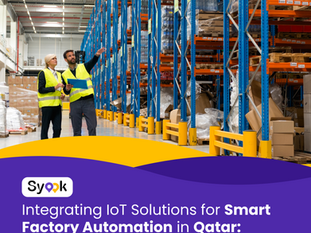
Enhancing Worker Safety with IoT Solutions in Qatar's Industrial Environments
Jan 16
3 min read
0
5
0
As Qatar continues its rapid industrial growth, ensuring worker safety in high-risk environments remains a critical concern. With industries ranging from construction to oil and gas operating at full throttle, integrating technology becomes not just a preference but a necessity. Enter IoT (Internet of Things), a game-changer in redefining safety standards for industrial environments.

The Industrial Safety Landscape in Qatar
Worker safety in Qatar has gained significant attention recently, especially with the nation’s focus on sustainable development as part of the Qatar National Vision 2030. Industrial environments are fraught with risks such as equipment malfunctions, hazardous material exposure, and human errors. Addressing these challenges requires a proactive, tech-driven approach.
Key Statistics
The International Labour Organization (ILO) reported that workplace injuries are more prevalent in heavy machinery and hazardous materials industries.
Qatar’s average summer temperatures exceed 40°C, increasing the risks of heat-related illnesses among outdoor workers.
Studies suggest that proactive safety measures, including IoT-based systems, can reduce workplace accidents by up to 25%.
How IoT is Transforming Worker Safety
IoT enables interconnected devices to collect and share real-time data, offering actionable insights that can save lives. Here's how IoT solutions are revolutionizing worker safety in Qatar's industrial settings:
1. Real-Time Monitoring and Alerts
IoT devices equipped with sensors can monitor workers’ health metrics such as heart rate, body temperature, and fatigue levels. Wearable devices can detect anomalies and immediately send alerts to supervisors. For instance, a worker showing signs of heat stress in Qatar's scorching summers can be attended to before a health crisis occurs.
Example Technologies:
Smart Wearables: Devices like smart helmets and vests embedded with sensors.
Environmental Sensors: Devices that track ambient temperature, humidity, and gas concentrations.
Real-time data can mean the difference between a proactive intervention and a preventable accident.
2. Hazard Detection and Response
IoT-enabled gas detectors can continuously monitor air quality, identifying harmful gases like methane or carbon monoxide in real-time. Similarly, vibration sensors on heavy machinery can predict potential breakdowns, preventing accidents caused by equipment failure.
Implementation Insights:
Deploy IoT-enabled gas detectors across high-risk zones.
Integrate vibration sensors into machinery maintenance protocols to automate predictive maintenance.
3. Geofencing and Location Tracking
IoT solutions allow for precise geofencing, ensuring workers stay within safe zones. This technology is particularly useful in construction sites and confined spaces. If a worker crosses a boundary, immediate notifications are sent to supervisors, ensuring quick action.
Practical Applications:
Construction sites with dynamically changing safety zones.
Confined spaces where unauthorized entry could lead to life-threatening risks.
4. Emergency Response Optimization
IoT devices integrated with emergency response systems can significantly reduce response times. During emergencies, connected devices can guide workers to the nearest exit or safe zone using digital maps.
Benefits:
Shorter evacuation times.
Enhanced coordination among emergency responders through centralized dashboards.
In high-risk environments, every second counts. IoT ensures we’re not just reacting but responding intelligently.
Synergies with Digital Twins
Digital twins—virtual replicas of physical assets—are enhancing the capabilities of IoT in worker safety. By simulating real-world conditions, digital twins can predict potential risks and test safety protocols in virtual environments before implementing them on-site.
Key Benefits of Digital Twins:
Risk scenario simulations to test safety measures.
Predictive analytics to foresee equipment failures.
Overcoming Implementation Challenges
Despite its benefits, implementing IoT solutions in Qatar’s industrial sector isn’t without hurdles:
High Initial Costs: The investment in IoT devices, software, and infrastructure can be significant.
Data Privacy Concerns: Continuous monitoring may raise privacy concerns among workers.
Skill Gaps: Training workers to use IoT tools effectively is essential but requires time and resources.
Solutions to Challenges:
Partnering with technology providers to create cost-effective implementation plans.
Developing clear privacy policies and obtaining worker consent.
Offering targeted training programs to bridge skill gaps.
Case Studies: IoT in Action
Example 1: Enhanced Heat Stress Management
In a construction project during Qatar’s peak summer season, IoT-enabled wearables monitored workers’ body temperatures and alerted supervisors when levels exceeded safe limits. This intervention reduced heat-related incidents by 30%.
Example 2: Gas Leak Detection in Oil Fields
An oil field deployed IoT-enabled gas detectors, which detected a minor methane leak before it escalated. This prevented potential health hazards and costly shutdowns.
A Future of Safer Workplaces
IoT solutions are not just a technological upgrade; they are a transformative force for worker safety in Qatar. As industries embrace these innovations, the results speak for themselves: reduced accidents, improved emergency responses, and enhanced worker well-being.
Technology doesn’t replace human oversight; it empowers it.
As we look to the future, adopting IoT solutions for worker safety isn’t just a step forward; it’s a leap toward sustainability and responsibility. Are you ready to transform your workplace into a safer, smarter environment?
Explore our comprehensive guide on IoT solutions for industrial safety to learn more.
Related Posts







